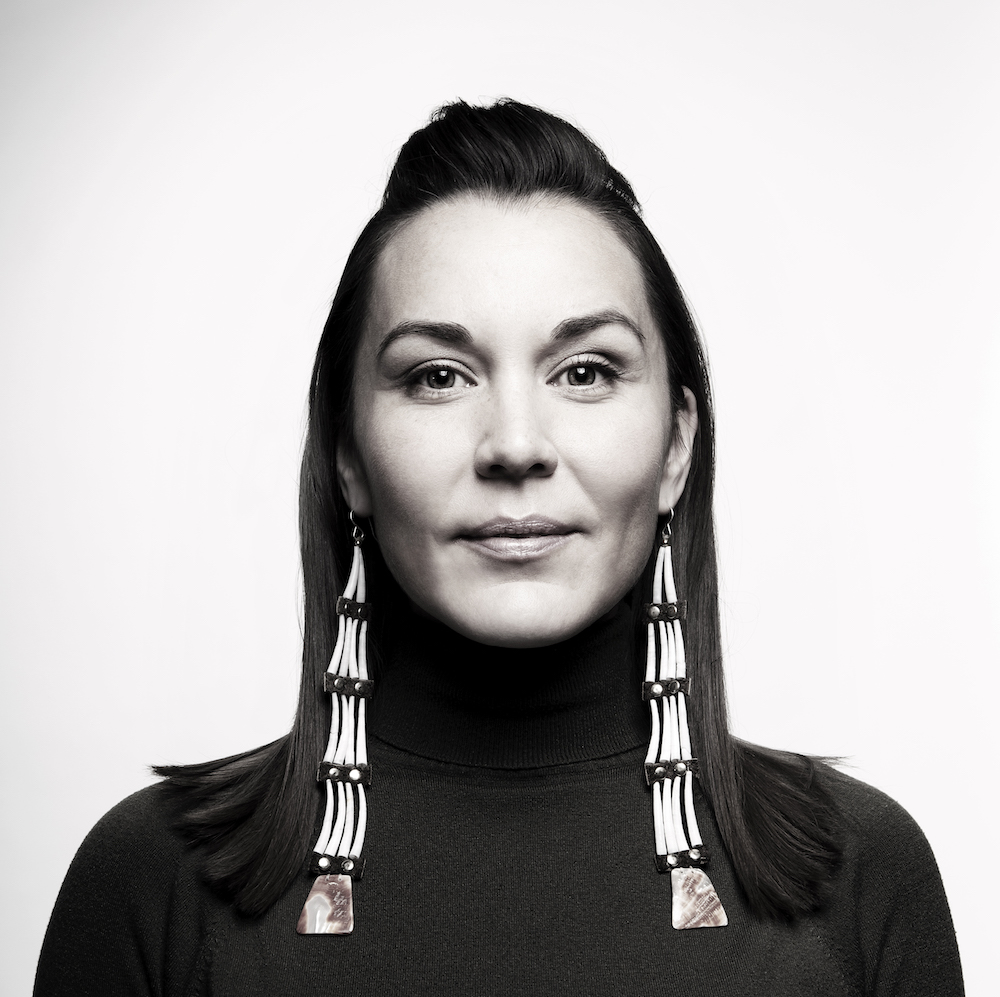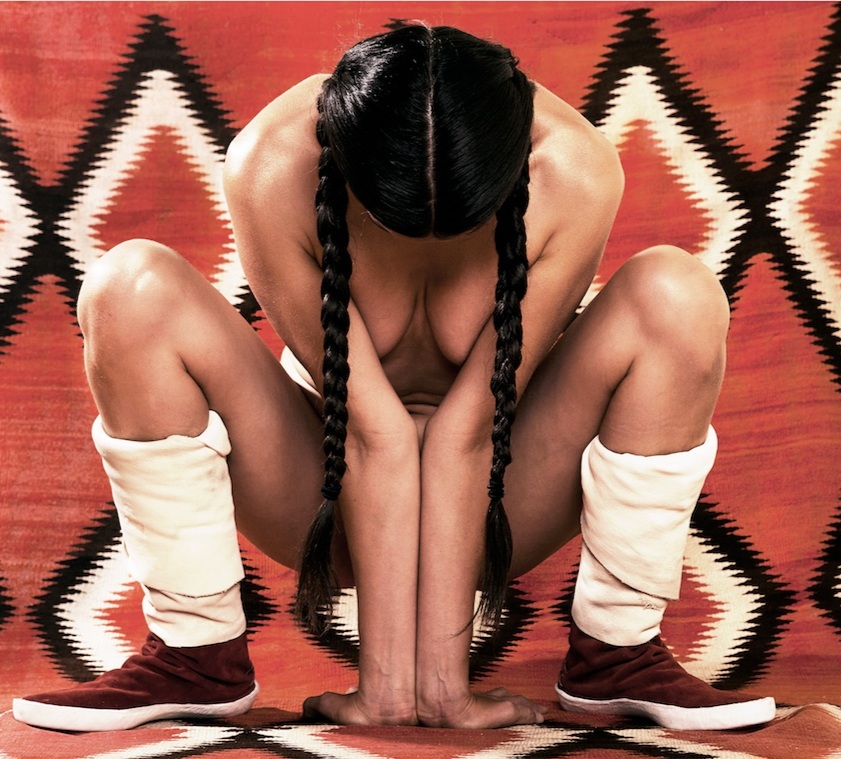Cara Romero
By Maria Manuela
Cara Romero is a visionary. Not because she imagines things beyond reality, or because she invents things for the future — but because she uses her medium of fine photography to present modern Native identities; she shows us the truth of how things are right now.
Nikki. Photography by Cara Romero
Saying Cara is accomplished rings flat to the truth of who this woman is, as she amasses evidence of her effect in awards and recognitions. Her work has been archived by the Smithsonian. She has won first-place awards at the Santa Fe Indian Market for digital photography every year since 2012 — and titles at the Heard Museum Guild Indian Fair and Market, including first place this year for her image titled Spirits of Siwavaats.
The images she creates are powerful and hypnotic. As a modern Native woman, Cara’s gaze and lens focus on the reality of the identity that flows through her. She portrays modern Indigenous people as beautiful, powerful and diverse — providing a space for Native people to see themselves represented.
“I am trying to embolden the conversation and reinforce — I think to my own audience — that we’re so powerful, Indigenous and modern; and that’s at the heart and soul of the work.”
Her images have a sense of magical realism, and Cara says the literary genre is one of her favorites. Her photographs present Native people bathed in supernatural auras. Even in photographs such as Water Memory (2015) and Eufaula Girls (2015) — which pay homage to the violent, historic flooding of tribal lands to construct federal dams — there’s a serenity to Cara’s subjects. As two women float through amber-hued water in Eufaula Girls, they smile toward the sunlight as they move effortlessly through the water as if they have superpowers.
I am trying to embolden the conversation and reinforce — I think to my own audience — that we’re so powerful, Indigenous and modern; and that’s at the heart and soul of the work.
When I look at Cara’s work, I see strong women, and I am inspired to be like those women.
“It was important to me that people understood how our indigeneity manifests today,” she says. “How can I remind not only the outside world, but ourselves, that we’re every bit as powerfully Indigenous as what those old photos convey. We look at the old Curtis prints and we see their resilience, and we see the power of the people. They’re from a different era, but how are we the same?”
Before Cara takes a picture, she shapes the image through sketches and interviews with her subjects. Knowing the people she photographs — and the stories that color their eyes and line their mouths — is paramount to her work.
Water Memory. Photography by Cara Romero
Eufala. Photography by Cara Romero
“I tell the stories I tell because I know the people, and we have a relationship. There’s a whole interview process where we’re co-creating this story together,” she says. “Sometimes I have an idea, and I match it with a friend or family member that I think it would resonate with. Other times it’s really about the person, and we’re trying to convey something that the outside world doesn’t know about contemporary Native people.”
How can I remind not only the outside world, but ourselves, that we’re every bit as powerfully Indigenous as what those old photos convey.
Introducing the world to the kaleidoscope of contemporary Native identities is Cara’s goal. Raised on the Chemehuevi Valley Indian Reservation in California next to Lake Havasu, she knows how damaging the singularity of one Indigenous identity can be for Indigenous people.
“The narrative and the content [are] very, very important. It’s so important because we have such a narrow narrative with Native art, and especially with Native photography,” she explains. “That one narrative has really affected my life. People tell you that you’re supposed to be one thing — and if you’re not this one thing then you have a personal crisis of like, well then what am I?”
Naomi. Photography by Cara Romero
First American Girls. Photography by Cara Romero
In 2013, Cara had an epiphany that allowed her to create this work.
“I had this breakthrough in voice, breakthrough in art, breakthrough in identity,” she recalls. “I realized all I have to do is be incredibly honest, incredibly true to myself. It was so healing. That’s what my photographs are now, little small truths.”
While there’s a specific aim to each of Cara’s photographs, she feels something else plays into the final product: “When it comes down to the entire creative process, it’s like you’re holding space. You’ve created this space for flow and process, and when things work out it feels very serendipitous. It’s like, this art wants to happen.”
She peers over my shoulder at her photograph Nikki hanging behind me in her studio. It shows a woman squatting with her hands firmly planted on the ground in front of her. Her long, dark braids hang on either side of her head and brush her wrists. You get a sense of her strength as you take in her mostly nude form, arms placed symmetrically to cover her nipples and form a third point of grounding on the earth. The background and floor of the image are covered in repeating black, red and white geometry, the shapes mimicking the woman’s pose.
“I can look at that and say how well thought out that was, but did I intend for all of those magnificent repeated patterns? Is it your subconscious that’s coming through, that’s making it happen?” she says. “Or is it some other energy or force? Some of it feels subconscious, you’re working in the subconscious, you’re pulling all of these experiences from different times and universes — but some of it feels a little magic.”
TV Indians. Photography by Cara Romero
In February 2019, one of Cara’s biggest projects debuted. She created huge billboards — featuring a series of photographs starring four small boys from her home at the Chemehuevi Valley Indian Reservation — for Desert X. The second edition of the road-trip exhibit invited 19 contemporary artists to create site-specific installations throughout Palm Springs and the Coachella Valley, on view from Feb. 9 through April 22.
Tears glitter in the corners of Cara’s eyes as she tells me about the project, describing it as affirming her path and changing her life. Coming from poverty, she often questioned her investment in photography — and in herself. She wondered if it was “silly” and if there were better things she could be doing for her family, and for herself.
“To get the billboards and have this incredible opportunity to create visibility for California Natives, for my tribe, for the Natives in Coachella Valley; I was the only person who could have pulled it off in the community,” she says. “In that moment, I felt this is why I’ve been doing this. I am able to communicate now at this high craft level, and those billboards are accessible to everybody. People see them for the next eight weeks that would never have thought about the issues they bring up.”
Around 200,000 people see Cara’s billboards each week, which means her images will affect more than 2 million humans during the exhibit’s 11 weeks in the desert. We speculate about the viewers together, imagining people from all walks of life looking into the eyes of those four children.
“I think some people still didn’t get it. I am from SoCal, and we have a great amount of invisibility,” she says. “We have one of the most brutal colonial histories in the United States, unbeknownst to most people. There’s been complete erasure. I think it would be shocking for people to really take a look; there are Natives in those spaces. In Palm Springs and Los Angeles, all over Coachella Valley, we’re everywhere but we’re invisible.”
Jack Rabbit Cottontail. Photography by Cara Romero
Cousins Truck. Photography by Cara Romero
Some media coverage of the billboards made Cara realize that, even when presented with giant images of modern Natives living in California, people still don’t get it. Many journalists don’t get it.
“They’ll say things like, ‘They’re images that depict the Natives that have historically occupied the area.’ And I say historically and presently, we’re still here,” she says. “You missed the whole thing: We’re trying to let you know we’re still here. I am trying to give you this visualization of what that means.”
I think it would be shocking for people to really take a look; there are Natives in those spaces. In Palm Springs and Los Angeles, all over Coachella Valley, we’re everywhere but we’re invisible.
But that doesn’t deter Cara, it spurs her to make more works like this, more public art: “It was an amazing opportunity to show in that medium. That was a pinnacle project for me, and it makes me want to do more public art because I see the power in it.”
There’s something ethereal and reverent about Cara’s photographs. I want to bow down to them; looking into the eyes of her subjects, I feel their legend and their presence. Part of the allure behind these works is the artist’s devotion: She honors her process like a spiritual practice.
“It feels really pure; the process is very pure. It’s relevant in these times to have something you feel good about when you go to work,” she says. “When you’re finished, it’s something [about which] you can ask: What have I done for my community? Have I honored myself and my community? Have I made a difference? Can I provide for my family?
“And when I can do that through art, it’s like, man, I’ve earned my place in the universe,” Cara says. “It’s a good feeling.”
Ty. Photography by Cara Romero
About the author: Maria Manuela is a writer based in Santa Fe, New Mexico where she was born and raised. She focuses on highlighting artists, designers and creative locals in her work which has been featured in publications like New Mexico Magazine, Good Mood, and THE Magazine. She curates and authors the arts section of UNUM, highlighting women who work in creative professions. She is also in the process of writing a short story collection of magical realism folk stories based in the Southwest.












